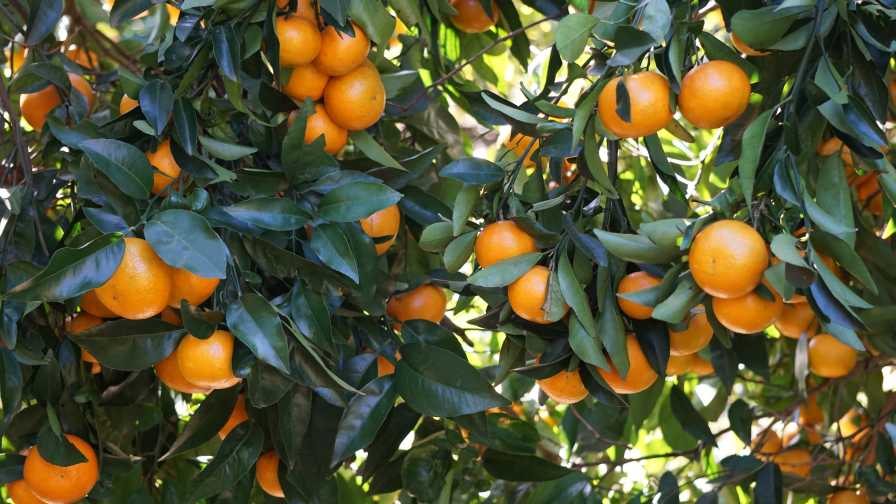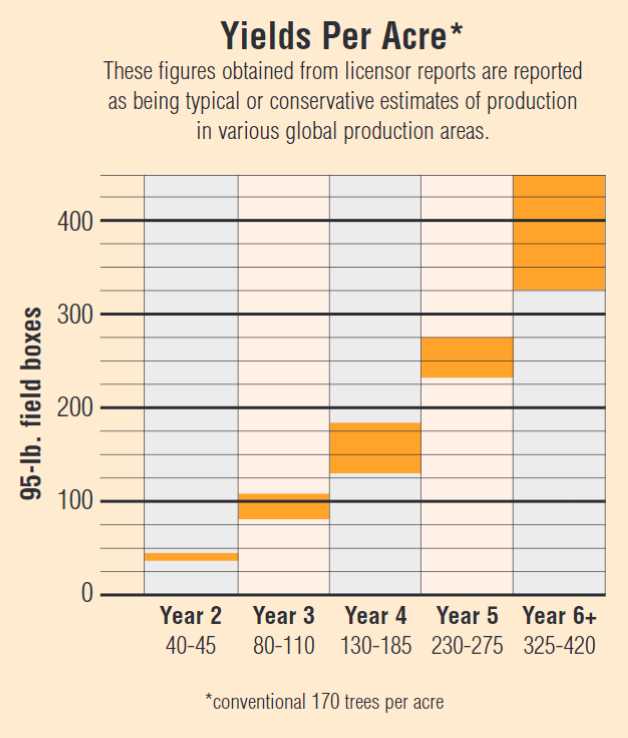
‘Orri’ mandarin is a hybrid selected from irradiated budwood after a series of crossings originating from Temple tangor and ‘Kinnow’ mandarin oranges.
Photo by Peter Chaires
The status of the ‘Orri’ mandarin permeated 2020 coffee shop talk among specialty citrus fruit growers. It was widely known that the patent had expired, and it was uncertain whether ‘Orri’ would become public domain or continue forward as a managed variety. Though growers continue to commit resources to trialing new experimental selections and hone their production practices with recently released Florida varieties, many are interested in planting specialty varieties with production and marketability track records in the near-term. The ‘Orri’ mandarin is one of the varieties that is getting increased attention.
It is important to note that “Citrus Nursery Source” seeks to be an objective source of information for nurseries and growers. This column is not about promotion. It is about informing the industry of choices and availability. However, when gathering information about citrus varieties and their availability, most of the information will generally originate from the breeder and/or primary licensor.
Background
‘Orri’ is a mandarin hybrid selected from irradiated budwood after a series of crossings originating from Temple tangor and ‘Kinnow’ mandarin oranges. The many years of development work were sponsored by Israel’s Agriculture Research Organization.
Since its release, ‘Orri’ has gained worldwide market acceptance and represents 80% of Israel’s exports to the U.S., Europe, and Asia. U.S. demand has been strong, and the variety is well suited to current Florida production, harvesting, and packing and shipping practices. The fruit appearance is very typical of a tangerine/mandarin. External color is acceptable, though generally not dark orange. Peel coloration is usually uniform. The fruit is easy-peel with very good flavor. Fruit size is typically 5 to 6 ounces with good internals: TSS 12.7, TSS/acid ratio 15.8.
It is reported to be highly resistant to Alternaria and black spot and, if managed, is considered less prone to alternate bearing. It has been classified as a tangerine/mandarin and, in most cases, meets the current mandarin standards in the Florida Department of Citrus Rules, enabling shippers to market it as a tangerine or mandarin.
While the Israeli breeders are careful not to claim that ‘Orri’ is resistant to HLB. Though, 10-year-old trees in Florida show some HLB symptoms, the trees seem to be less affected than other varieties, and the ‘Orri’ trees are still producing very good crops. This may be due to the fact its parentage includes ‘Kinnow’, which has been rumored in the Punjab region of India to be tolerant to Indian citrus greening.
Maturity Window
Florida harvesting begins in late November (almost two months ahead of California). Fruit can hold on the tree until as late as April in arid climates, but harvest appears to last through February most years in Florida. The ‘Orri’ stores well and travels well over long distances.
Economics
The licensor reports that it is necessary to follow specific production practices in order to achieve optimum fruit size and full-potential yields, reduce alternation and lower harvesting costs. Such practices include timely chemical applications at flowering and post-fruit set thinning. After the trees are 3 to 4 years old, annual girdling is necessary, as well as implementation of a rigorous pruning program. Production guidance and training is available. Pruning to limit tree height to 10-12 feet reduces harvesting costs and provides more light to tree interiors, thereby increasing yields per tree. Perhaps its primary drawback is the need for solid blocks, isolated from other viable pollen sources. ‘Orri’ will produce seed if grown too close to hot pollen.
Rootstocks
‘Orri’ is suitable for a wide range of rootstocks. In good growing conditions, Citrumelo, Carrizo, C35, US-812, US-942, and Sour Orange give very good results.
Market Presence
Summer supply to the U.S. from South America is helping to develop and maintain a year-round market presence in supermarkets. Florida production should enter U.S. supermarket shelves before California winter production and Israeli exports that begin in January/February.
Tree Availability
Trees are currently available only from Southern Citrus Nurseries, LLC (SCN), Dundee, FL. SCN has made significant investments in order to meet expected demand for registered ‘Orri’ nursery trees. In the event that SCN cannot meet demand, other Florida nurseries will be contracted by the ‘Orri’ licensor.
The ‘Orri’ variety carries a one-time tree license fee. The new program no longer has minimum acreage requirements, though larger solid blocks are recommended.
Author note: The Israeli citrus varieties are represented in the U.S. by International Plant Genetics and Technologies, LLC, Miami, FL. Contact: Dan Gelfman. email: ipgtllc@gmail.com.










